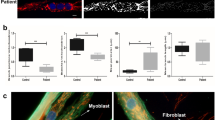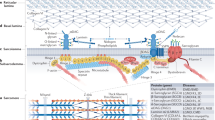Abstract
Duchenne muscular dystrophy (DMD), the most common and severe form of the muscular dystrophies, is an X-linked inborn error of metabolism with multiple tissue involvement. Although the major pathological changes are observed in skeletal muscle, abnormalities have also been detected in the heart1, nervous system2, red blood cells3, lymphocytes4 and cultured skin fibroblasts5–7. For many reasons, such as readily available tissue material, fewer secondary changes and the potential for prenatal diagnosis, cultured skin fibroblasts should be the tissue of choice to search for the primary defect. Several abnormalities have been reported in DMD fibroblasts, suggesting that the genetic abnormality is expressed in these cells5–7. To search for potentially mutant protein(s) we have compared the protein composition of normal and DMD fibroblasts by two-dimensional gel electrophoresis and have now found one protein spot consistently missing in DMD cells. The nature of this protein and its relation to the DMD gene are unknown.
This is a preview of subscription content, access via your institution
Access options
Subscribe to this journal
Receive 51 print issues and online access
$199.00 per year
only $3.90 per issue
Buy this article
- Purchase on Springer Link
- Instant access to full article PDF
Prices may be subject to local taxes which are calculated during checkout
Similar content being viewed by others
References
Hunter, S. Br. med. Bull. 36, 133–134 (1980).
Emery, A. E. H. & Gosden, C. J. med. Genet. 11, 76–79 (1974).
Plishker, G. A. & Appel, S. H. Muscle Nerve 3, 70–81 (1980).
Hornstein, A. L. & Emery, A. E. H. Neurology 30, 1330–1332 (1980).
Jones, G. E. & Witkowski, J. A. J. neurol. Sci. 43, 465–470 (1979).
Gelman, B. B. et al. J. clin. Invest. 65, 1398–1406 (1980).
Rounds, P. S. et al. Biochem. biophys. Res. Commun. 97, 1384–1390 (1980).
Pena, S. D. J. et al. Clin. Genet. 14, 50–54 (1978).
O'Farrell, P. H. J. biol Chem. 250, 4007–4021 (1975).
Walton, K. E., Styer, D. & Gruenstein, E. J. biol. Chem. 254, 7951–7960 (1980).
Oakley, B. R., Kirsch, D. R. & Morris, N. R. Analyt. Biochem. 105, 361–363 (1980).
Lyon, M. F. A. Rev. Genet. 2, 31–52 (1968).
Pena, S. D. J. & Wrogemann, K. Pediat. Res. 12, 887–893 (1978).
Wrogemann, K. et al. Analyt. Biochem. 81, 472–477 (1977).
Author information
Authors and Affiliations
Rights and permissions
About this article
Cite this article
Rosenmann, E., Kreis, C., Thompson, R. et al. Analysis of fibroblast proteins from patients with Duchenne muscular dystrophy by two-dimensional gel electrophoresis. Nature 298, 563–565 (1982). https://doi.org/10.1038/298563a0
Received:
Accepted:
Issue Date:
DOI: https://doi.org/10.1038/298563a0
This article is cited by
Comments
By submitting a comment you agree to abide by our Terms and Community Guidelines. If you find something abusive or that does not comply with our terms or guidelines please flag it as inappropriate.



